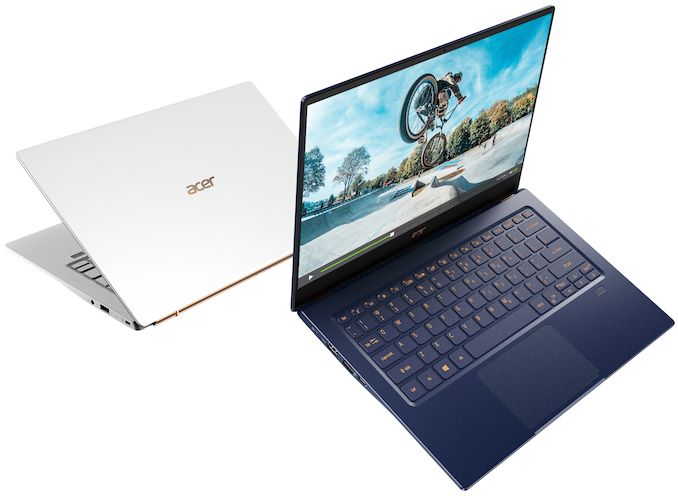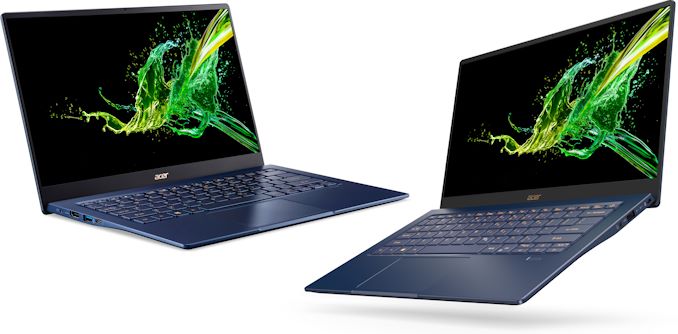Acer Launches 2019 Swift 5: 14-Inch, Ice Lake, GeForce MX 250, 990 Grams
by Anton Shilov on September 4, 2019 4:55 AM EST
Acer introduced its new ultra-portable Swift 5 notebook at its Next@Acer event in Berlin, Germany. Weighing less than 1 kilogram, the new 14-inch machine appears to be one of the industry’s thinnest and lightest laptops with discrete graphics.
To minimize the weight, the Acer Swift 5 notebook comes in a chassis made of magnesium-lithium as well as magnesium-aluminum alloys that is only 14.95 mm thick. Besides, the system is equipped with a 14-inch Full-HD IPS display with three-side narrow bezels and a screen-to-body ratio of 86.4%.
The Swift 5 is based on Intel’s 10th Generation Core processor codenamed Ice Lake with up to four cores as well as Intel Iris Pro Graphics that can be optionally accompanied by NVIDIA’s discrete GeForce MX 250 discrete GPU. The laptop naturally uses LPDDR4X RAM for power efficiency as well as an up to 512 GB PCIe 3.0 x4 SSD.
As far as connectivity is concerned, the system is equipped with a Thunderbolt 3 port as well as Wi-Fi 6 + Bluetooth 5 wireless technologies. Meanwhile, the system also has a fingerprint reader as well as a webcam with IR sensors for Windows Hello login.
Acer says that the Swift 5 laptop can work for up to 12.5 hours on one charge (based on testing using Web browsing) when equipped with Intel’s 10th Gen Core i5, NVIDIA’s GeForce MX 250, 16 GB LPDDR4X, and with a Full-HD display set at 100 nits brightness.
Acer’s Swift 5 will hit the market later this month. Pricing will depend on exact configurations and will vary from region to region. In EMEA, the machine will cost starting from €899.
Related Reading:
- Acer’s 14-Inch Swift 3 Gets Whiskey Lake-U CPU, GeForce MX150, Goes on a Diet
- Acer’s Swift 3 Laptop Gets 13.3-Inch Display, Slimmer Chassis, LTE Modem
- Acer’s New Swift 7 Gets 14-inch Display, LTE Modem, Becomes Thinner & Pricier
Source: Acer












14 Comments
View All Comments
damianrobertjones - Wednesday, September 4, 2019 - link
Unless you like to game at 1280x720, adding the MX 250 is more or less pointless. Heck, the iGPU of the 10th gen cpu will probably be faster (ish).Why do they do this? It's a complete waste of resources?
ChuckNorris89 - Wednesday, September 4, 2019 - link
>Why do they do this? It's a complete waste of resources?Because marketing. Consumers will see a dedicated GPU and think it must be miles better than competing iGPU models.
It bugs me too. Rather they saved the money of that useless GPU and stick with the iGPU for better battery life, cost and lightness.
AshlayW - Wednesday, September 4, 2019 - link
One (probably niche, admitedl) advantage of the GeForce chip is the ability to work with CUDA, which AFAIK, has much greater support than OpenCL on Intel's GPU architecture. Though it's interesting to note the Ice-Lake's "Sunny Cove" cores feature AVX512 from what I read, which would be handy for the sort of vector operations one would use CUDA on a GPU for.Death666Angel - Wednesday, September 4, 2019 - link
Not everything is AAA gaming. And the dedicated 4 GB of VRAM will help in many scenarios. Also, this will mean that the whole TDP budget of the CPU will be for the CPU and not have the iGPU cut into that budget. If I have the option of an iGPU laptop and a dGPU MX250 laptop which costs negligibly more and has otherwise the same specs, I'd probably choose the MX250.isthisavailable - Wednesday, September 4, 2019 - link
But then why even bother with ice lake? Comet Lake is cheaper and mostly same because it clocks much higherStevoLincolnite - Wednesday, September 4, 2019 - link
It should offer a 2x-3x more performance than the iGPU of the Intel chip... The 56GB/s of bandwidth makes all the difference over the (probably) 38.4GB/s of the Intel part that has to share it's bandwidth and TDP with the CPU.Not to mention that Intels drivers are significantly superior to Intels, plus Pascal generally has some architectural efficiency advantages on a multitude of fronts. (Does Intel even do Colour Compression? Not entirely sure.)
Either way, it's not a Geforce GTX 1050... But it's also not a Geforce MX 110 with DDR3 either.
AshlayW - Wednesday, September 4, 2019 - link
The Ice-Lake CPUs are using Intel's new Gen11 graphics architecture on the 10nm process. The MX250 is a lower clocked mobile version of the GT1030, a card that isn't actually that much faster than the best current Integrated graphics (2400G, 3400G). Ice Lake Iris Plus will be more efficient and almost certainly uses some form of Delta Colour Compression, it also supports Variable Rate Shading where the Pascal part does not.I think, that the MX250 would be a bit faster (but not by much) in gaming workloads. But the Ice-Lake iGPU will be significantly more efficient.
AshlayW - Wednesday, September 4, 2019 - link
I also meant to say, that the MX250 is nowhere near "2-3X" faster than the Ice Lake's Iris Plus integrated graphics, I think 20% is a safe bet.poohbear - Friday, November 22, 2019 - link
MX250 being "2-3 times" faster than IGPU is definitely NOT the situation; the new IGPU for Ice Lake is very impressive and it holds its own. Which takes us back to OP who pointed out it is indeed a waste of resources.ET - Wednesday, September 4, 2019 - link
Intel has only one SKU with the fastest performing graphics, which might reach that level (and I'm not sure about that; what are you basic your assumption that it will be faster on?).OEMs tend to use discrete GPUs even in the case when they're not that much faster than integrated GPUs in order to provide a consistent experience, regardless of the CPU or CPU RAM speed / channels. (And of course because discrete is a selling point regardless of how crappy it is.)